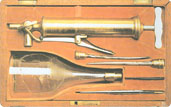About Us
Purpose
In recent years, as more and more historians of science and technology have found employment in museums, there has been a growing recognition that objects have not received sufficient attention in serious historical studies, and even in exhibits they more often serve as icons than as significant evidence. The purpose of Artefacts is to help resolve this problem by providing an annual forum where historians from museums and universities can discuss issues, by publishing collections of articles (based on the meetings) through which an appropriate historiography can be developed, and by other means as may be determined.
Brief History
In the fall of 1993, at the meeting of the Society for the History of Technology in Washington, Robert Bud (Science Museum) and Bernard Finn (Smithsonian) talked about this need. In the following months Helmuth Trischler (Deutsches Museum) was easily persuaded to join the effort and an energetic email correspondence ensued. First thoughts leaned towards a periodical, but our potential publisher (Harwood Academic Publishers) persuaded us that a book series made more sense, with each volume focusing on a different topic. Harwood produced the first two volumes; the Science Museum Press published the next four; and beginning with volume 7 the Smithsonian Institution Scholarly Press has assumed the responsibility.
It was felt that just as important as the production of publications would be the creation of opportunities for academic and museum professionals to get together in a structured but still informal setting. Thus began the tradition of an annual meeting where topic-oriented presentations and serious discussion of the state of historical museums of science and technology were conducted in an atmosphere that promoted collegiality.
The initial meeting was appropriately at the time of the SHOT conference in London in 1996, with a focus on medicine and health. The first volume of Artefacts: Studies in the History of Science and Technology with the title Manifesting Medicine appeared in 1999. It is important to note that neither this book nor any of those that followed was a "proceedings" of the meeting. Rather, the meeting acted as a sounding board, from which we determined whether the topic deserved full print treatment. Some of the articles came from the meeting, others were independently solicited. Indeed, not all meetings have produced volumes, though there is a chance that some topics left in abeyance may still appear in the series.
Editorial responsibility for the initial volumes was assumed by Bud, Finn and Trischler, often with the assistance of others for particular volumes. This arrangement changed with the sixth volume when Martin Collins agreed to assume the position of Managing Editor, where he oversees the work of the editors (usually two) of the individual volumes. He also is our principal liaison with the Press. He has the help of an
Editorial Advisory Board:
Robert Anderson, Cambridge University
Randall Brooks, Canada Science and Technology Museum
Ruth Cowan, University of Pennsylvania
Robert Friedel , University of Maryland
Sunghook Hong, Seoul National University
David Hounshell, Carnegie Mellon University
Otmar Moritsch, Technisches Museum Wien
Peter Morris, Science Museum
Ulf Hashagen, Deutsches Museum
Thomas Söderqvist, Medicinsk Museion Kobenhavns Universitet
Liba Taub, Whipple Museum of the History of Science
Helena Wright, Smithsonian Institution
Tom Zeller, University of Maryland
Elsewhere on this site you can find a listing of meetings and publications, with further details.
Prospects
We think it is fair to say that we have met basic expectations of organizing a series of well-attended (average about fifty people) meetings in collegial settings with interesting presentations and lively discussions. And we have been pleased with the contents and appearance of the publications. With that as a base, it is our intention now, with the posting of this website (in 2011), to reach out more aggressively to museums and academic programs. We feel that we have provided a framework for the more effective use of objects in both publications and exhibits. It is time to obtain input from a broader range of colleagues and to make our findings more widely available. Please return to the site to keep abreast of our progress, and let us have the benefit of your comments and advice.

